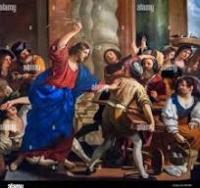
John’s account of the cleansing of the temple is placed at the beginning of Jesus’ ministry, unlike the synoptic gospels which place it near his passion. There are many explanations for this. It may be that John wanted to establish early on in his gospel the authority of Jesus and the fact through his passion and death he would be the new temple. The story might therefore be seen as his ministry in miniature.
John’s version of the story is the most violent, with Jesus driving out the sellers with a whip. The temple was the focal point of the Jewish religion as God’s dwelling place; even today, Jews gather at the wailing wall in Jerusalem, the nearest site to the Holy of Holies, to mourn its loss. Something had gone very wrong when money-changers and traders were doing their business in the Court of the Gentiles, which was the only place the non-Jews could go to pray. It would have been impossible to do this with the noise of what was essentially a market.
In the Apocalypse, John‘s vision poetically describes God’s presence without the temple: “The holy city of Jerusalem coming down out of heaven from God, prepared as a bride adorned for her husband” (Apoc. 21:2-3).
“I saw no temple in the city, for its temple is the Lord God the Almighty and the Lamb” (Apoc. 21:22-23).